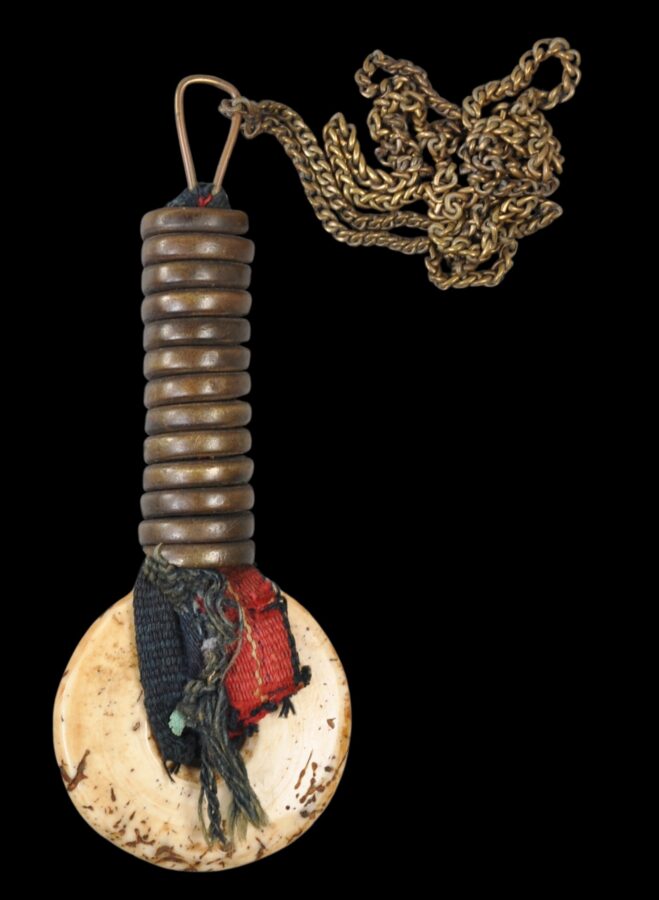Enquiry about object: 9702
Rare Himalayan Brass Coil & Shell Pendant Necklace
Tibetan Peoples, Lahaul and Spiti, Himachal Pradesh, Himalayan India 19th century
length of pendant: 13.1cm, width of pendant: 5.1cm, circumference of chain: 70cm, weight: 119g
Provenance
private collection, Scotland
This very rare and particularly striking pendant and chain is from the Lahaul (Lahul) and Spiti Districts in the north of India’s northern Himachal Pradesh state in the Himalayas. Related ornaments were worn in Ladakh.
It comprises a round doughnut-shaped disk carved from thick chank shell. The shell itself has excellent patina and smoothness from wear and years of handling. Most likely, it was used as a ‘washer’ for a hand-held prayer wheel. The metal of the wheel slowly cuts the shell until it widens out the core so that the shell-washer needs to be replaced. These shell pieces are then collected and can be used as an amulet, as is likely here – having been used for a sacred purpose, the shell is seen as having talismanic properties.
Another view is that it came from an earlier piece of jewellery – it might have been used as a hair ring, possibly in Tibet itself.
It is attached to a thick copper coil by means of two copper wires that have been wrapped in textile presumably to protect the shell, which suggests the value that must have been placed on it.
The overall pendant has been attached to a fine copper chain to allow it to be worn around the neck.
Overall, the pendant and chain have the most splendid patina, with the contours being softened from years of handling.
A dating of 19th century has been assigned but it could be earlier.
Ornaments made from shells were prestige pieces – there were no local supplies and the shell components were brought to the mountainous region by traders. Their imported status meant that they were expensive and so were considered luxury goods by the wearers. The marine origins of shell components and the association with fish meant that items made from such components were associated with fertility and so were ideal items for women to wear.
Lahaul (Lahul) and Spiti Districts are small in terms of population an even today have a combined population of slightly more than 30,000. The population is generally of Tibetan or related ancestry and the majority ethnic group is the Sino-Tibetan Kinnaur people. Generally, the locals follow a combination of Hinduism and Tibetan Buddhism of the Drukpa Kagyu order, or Tibetan Buddhism of the Gelugpa order.
The ornament has come from an old collection in Scotland, likely to have been put together by a colonial administrator serving in the region. (Scots were commonly involved in the colonial administration of India.)
References
van Cutsem, A., A World of Head Ornaments: Africa, Asia Oceania, America, Skira, 2005.
Daalder, T., Ethnic Jewellery and Adornment: Australia, Oceania, Asia, Africa, Ethnic Art Press/Macmillan, 2009.
Geoffroy-Schneiter, B., Asian Jewellery: Ethnic Rings, Bracelets, Necklaces, Earrings, Belts, Head Ornaments, Skira, 2011.
Mealey, Nathan, pers. comm., 2024.





